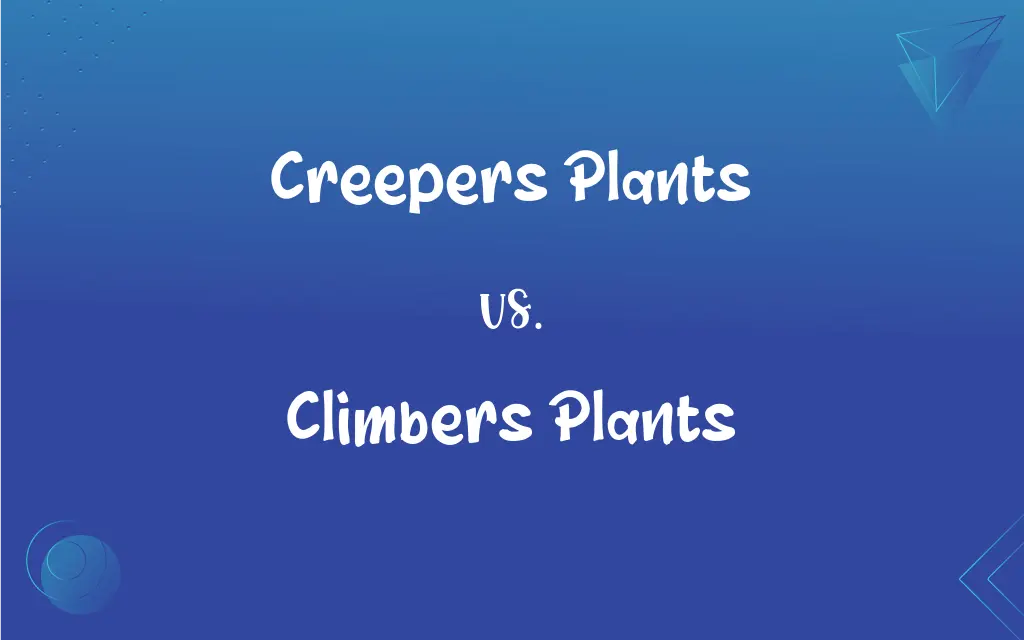Creepers Plants vs. Climbers Plants: What's the Difference?
Edited by Aimie Carlson || By Harlon Moss || Published on February 9, 2024
Creepers are plants that grow horizontally along the ground, while climbers are plants that grow vertically with support from structures or other plants.

Key Differences
Creepers plants spread out horizontally on the ground, often rooting at various points along their stems. They have a tendency to cover the ground surface. In contrast, climbers plants grow vertically and use external support to climb up surfaces, using tendrils, twining stems, or other specialized structures.
The stems of creepers plants are generally weak and cannot stand upright, hence they spread on the ground. Climbers plants, on the other hand, have more flexible stems, but still require support to grow upward, which they find through other plants, trellises, or walls.
Creepers plants are often used as ground covers in gardens due to their low-growing nature. They are ideal for covering the soil and providing a green carpet effect. Climbers plants are popular for vertical gardening, as they can cover walls, trellises, and fences, adding height and greenery to garden spaces.
In terms of propagation, creepers plants can often be propagated through stem cuttings that root easily. Climbers plants may also be propagated in this way but often require a structure for initial support as they grow.
Some common examples of creepers plants include strawberry, ivy, and ground ivy. Examples of climbers plants include grapevine, clematis, and morning glory, which climb using various mechanisms.
ADVERTISEMENT
Comparison Chart
Growth Direction
Horizontally along the ground
Vertically with support
Stem Characteristics
Weak, unable to stand upright
Flexible, requiring support
Garden Use
Ground covers
Vertical gardening elements
Propagation
Often through stem cuttings
Requires support for growth
Common Examples
Strawberry, Ivy
Grapevine, Clematis
ADVERTISEMENT
Creepers Plants and Climbers Plants Definitions
Creepers Plants
Ground-hugging plants with weak stems.
Strawberry plants are creepers, spreading out to cover the soil.
Climbers Plants
Plants with flexible stems that need support to grow upward.
We installed a fence for the morning glory, a climbers plant, to twine around.
Creepers Plants
Vegetation that forms a low, dense mat on the ground.
Creepers plants like ground ivy are excellent for controlling soil erosion.
Climbers Plants
Vertical-growing plants often used in ornamental gardening.
Climbers plants add height and drama to garden designs.
Creepers Plants
Plants that grow horizontally across the ground.
The garden path was lined with ivy, a type of creepers plants.
Climbers Plants
Vegetation that uses structures or other plants for vertical growth.
The garden wall was adorned with clematis, a beautiful climbers plant.
Creepers Plants
Plants that spread across surfaces rather than growing upwards.
The landscaper used creepers plants to create a green carpet effect.
Climbers Plants
Plants that grow vertically using external support.
Grapevines, a type of climbers plants, were growing up the trellis.
Creepers Plants
Plants that grow along the ground and root at intervals.
The backyard was covered with a variety of creepers plants, adding lushness.
Climbers Plants
Plants that can ascend on other objects for support.
Climbers plants like ivy can transform a bare wall into a green facade.
FAQs
Do creepers plants need support for growth?
No, they spread on the ground without support.
Are creepers plants suitable for covering large areas?
Yes, they spread out and cover ground effectively.
Can creepers plants be used for soil erosion control?
Yes, their ground-hugging nature helps control erosion.
Do creepers plants have deep root systems?
Generally, they have shallow roots.
What defines climbers plants?
Plants that grow vertically using support.
Can climbers plants be grown on walls?
Yes, with appropriate support structures.
What defines creepers plants?
Plants that grow horizontally along the ground.
Are climbers plants good for small gardens?
Yes, they add vertical interest without occupying much ground space.
Are creepers plants suitable for all soil types?
They generally adapt to a variety of soils but prefer well-drained types.
Are creepers plants fast-growing?
Many species are fast-growing, quickly covering surfaces.
Can creepers plants grow in pots?
Yes, but they are best suited for ground coverage.
Do climbers plants have strong stems?
Their stems are flexible but not strong enough to stand upright without support.
What are common uses of creepers plants in landscaping?
As ground covers, lawn alternatives, and for beautifying walls.
How do climbers plants climb?
Through tendrils, twining, or clinging roots.
Do creepers plants require a lot of sunlight?
It varies; some prefer shade, while others need full sun.
What types of supports do climbers plants need?
Trellises, arbors, wires, or supportive structures.
Can climbers plants damage the structures they grow on?
Some types can, especially if the structure is not sturdy.
Do climbers plants need special care?
They require support and occasional pruning.
Can climbers plants be used for privacy screens?
Yes, they can create natural green screens.
How do creepers plants propagate?
Usually through stem cuttings or runners.
About Author
Written by
Harlon MossHarlon is a seasoned quality moderator and accomplished content writer for Difference Wiki. An alumnus of the prestigious University of California, he earned his degree in Computer Science. Leveraging his academic background, Harlon brings a meticulous and informed perspective to his work, ensuring content accuracy and excellence.
Edited by
Aimie CarlsonAimie Carlson, holding a master's degree in English literature, is a fervent English language enthusiast. She lends her writing talents to Difference Wiki, a prominent website that specializes in comparisons, offering readers insightful analyses that both captivate and inform.
































































